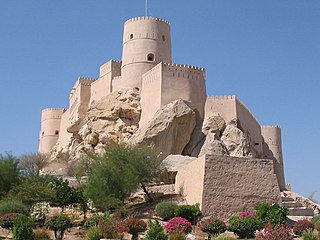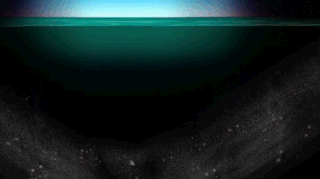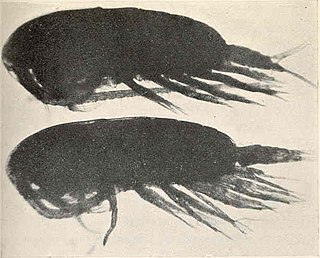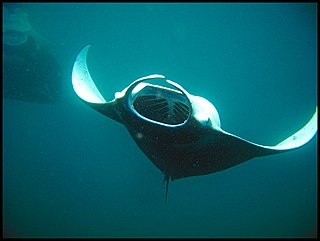Related Research Articles

Oman, officially the Sultanate of Oman, is a country located in West Asia. It is situated on the southeastern coast of the Arabian Peninsula, and spans the mouth of the Persian Gulf. It shares land borders with Saudi Arabia, United Arab Emirates, and Yemen, while sharing maritime borders with Iran and Pakistan. The capital and largest city is Muscat. Oman has a population of nearly 4.7 million and is ranked the 124th most-populous country. The coast is formed by the Arabian Sea on the southeast, and the Gulf of Oman on the northeast. The Madha and Musandam exclaves are surrounded by United Arab Emirates on their land borders, with the Strait of Hormuz and the Gulf of Oman forming Musandam's coastal boundaries.

Oman is the site of pre-historic human habitation, stretching back over 100,000 years. The region was impacted by powerful invaders, including other Arab tribes, Portugal and Britain. Oman once possessed the island of Zanzibar on the east coast of Africa as a colony. Oman also held Gwadar as a colony for many years.

The walrus is a large pinniped marine mammal with discontinuous distribution about the North Pole in the Arctic Ocean and subarctic seas of the Northern Hemisphere. It is the only extant species in the family Odobenidae and genus Odobenus. This species is subdivided into two subspecies: the Atlantic walrus, which lives in the Atlantic Ocean, and the Pacific walrus, which lives in the Pacific Ocean.

Muscat is the capital and most populated city in Oman. It is the seat of the Governorate of Muscat. According to the National Centre for Statistics and Information (NCSI), the total population of Muscat Governorate was 1.72 million as of September 2022. The metropolitan area spans approximately 3,500 km2 (1,400 sq mi) and includes six provinces called wilayats, making it the largest city in the Arabian Peninsula by area. Known since the early 1st century AD as an important trading port between the west and the east, Muscat was ruled by various indigenous tribes as well as foreign powers such as the Persians, the Portuguese Empire and the Ottoman Empire at various points in its history. A regional military power in the 18th century, Muscat's influence extended as far as East Africa and Zanzibar. As an important port-town in the Gulf of Oman, Muscat attracted foreign traders and settlers such as the Persians, Balochs and Sindhis. Since the accession of Qaboos bin Said as Sultan of Oman in 1970, Muscat has experienced rapid infrastructural development that has led to the growth of a vibrant economy and a multi-ethnic society. Muscat is termed as a Beta - Global City by the Globalization and World Cities Research Network.

Diel vertical migration (DVM), also known as diurnal vertical migration, is a pattern of movement used by some organisms, such as copepods, living in the ocean and in lakes. The adjective "diel" comes from Latin: diēs, lit. 'day', and refers to a 24-hour period. The migration occurs when organisms move up to the uppermost layer of the water at night and return to the bottom of the daylight zone of the oceans or to the dense, bottom layer of lakes during the day. DVM is important to the functioning of deep-sea food webs and the biologically-driven sequestration of carbon.

Celebrity Solstice is the lead ship of the Solstice class of cruise ships operated by Celebrity Cruises. Built by Meyer Werft in Papenburg, Germany, she was floated out on 10 August 2008, and christened by ocean scientist Professor Sharon L. Smith at a ceremony in Fort Lauderdale, Florida, United States, on 14 November 2008. The first post-Panamax vessel in the Celebrity fleet, she features innovative interior design and onboard amenities, including an ocean-going live grass lawn, a glassblowing studio, and a 12 deck-high atrium.

Calanus finmarchicus is a species of copepod and a component of the zooplankton, which is found in enormous amounts in the northern Atlantic Ocean.
Acartia hudsonica is a species of marine copepod belonging to the family Acartiidae. Acartia hudsonica is a coastal, cold water species that can be found along the northwest Atlantic coast.

Bawshar is one of the wilayats of Muscat, in northeastern Oman. The province borders wilayat Muttrah in the east and Muscat International Airport in the west, it overlooks the Sea of Oman from the north. It contains several archaeological sites and the Qurm Nature Reserve Ramsar site.

A planktivore is an aquatic organism that feeds on planktonic food, including zooplankton and phytoplankton. Planktivorous organisms encompass a range of some of the planet's smallest to largest multicellular animals in both the present day and in the past billion years; basking sharks and copepods are just two examples of giant and microscopic organisms that feed upon plankton. Planktivory can be an important mechanism of top-down control that contributes to trophic cascades in aquatic and marine systems. There is a tremendous diversity of feeding strategies and behaviors that planktivores utilize to capture prey. Some planktivores utilize tides and currents to migrate between estuaries and coastal waters; other aquatic planktivores reside in lakes or reservoirs where diverse assemblages of plankton are present, or migrate vertically in the water column searching for prey. Planktivore populations can impact the abundance and community composition of planktonic species through their predation pressure, and planktivore migrations facilitate nutrient transport between benthic and pelagic habitats.
Deborah K. Steinberg is an American Antarctic biological oceanographer who works on interdisciplinary oceanographic research programs. Steinberg's research focuses on the role that zooplankton play in marine food webs and the global carbon cycle, and how these small drifting animals are affected by changes in climate.

Barrow Canyon is a submarine canyon that straddles the boundary between the Beaufort and Chukchi seas. Compared to other nearby areas and the Canada Basin, the highly productive Barrow Canyon supports a diversity of marine animals and invertebrates.
Karen Frances Wishner is an American oceanographer currently at University of Rhode Island and an elected fellow of the American Association for the Advancement of Science. Her interests include coastal shelf and zooplankton behavior and environment, and has published her findings.

The lipid pump sequesters carbon from the ocean's surface to deeper waters via lipids associated with overwintering vertically migratory zooplankton. Lipids are a class of hydrocarbon rich, nitrogen and phosphorus deficient compounds essential for cellular structures. This lipid carbon enters the deep ocean as carbon dioxide produced by respiration of lipid reserves and as organic matter from the mortality of zooplankton.
Cindy Lee is a retired Distinguished Professor known for her research characterizing the compounds that comprise marine organic matter.

Ann Bucklin is Professor Emeritus of Marine Sciences at the University of Connecticut known for her work using molecular tools to study zooplankton. Bucklin was elected a fellow of the American Association for the Advancement of Science in 1995.
Carin Jessica Ashjian is an American biological oceanographer who is an associate scientist at the Woods Hole Oceanographic Institution. She studies how the physical environment influences the distribution of plankton in the Beaufort Sea.
Kendra Lee Daly is an oceanographer known for her work on zooplankton, particularly in low oxygen regions of the ocean. She is a professor at the University of South Florida, and an elected fellow of the American Association for the Advancement of Science.
Stephanie Louise Pfirman is a professor at Arizona State University known for her work on sea ice, pollutants in sea ice, and how sea ice is changing over time. She is a fellow of the American Association for the Advancement of Science.
Callianira antarctica is a species of ctenophore that physically resembles Mertensia ovum, but lacks the oil sacs. Just like other ctenophores, over 95% of its body mass and composition is water.
References
- ↑ "Sharon L. Smith | The Rosenstiel School of Marine and Atmospheric Science at the University of Miami". 2018-03-19. Archived from the original on 2018-03-19. Retrieved 2021-05-12.
- ↑ "Dr. Sharon L. Smith | GulfBase". www.gulfbase.org. Retrieved 2021-05-12.
- 1 2 "Peak Profile: Sharon L. Smith '67 | Bulletin". sites.coloradocollege.edu. Retrieved 2021-05-13.
- 1 2 Gelder, Lawrence Van (1979-06-10). "Oceanographer Is Making a Voyage of Discovery". The New York Times. ISSN 0362-4331 . Retrieved 2021-05-13.
- ↑ "Ms. Smith goes to sea" (PDF). Brookhaven Bulletin. Vol. 33, no. 18. Brookhaven National Laboratory. May 4, 1979. pp. 1, 3.
- 1 2 Staff, C. I. N. (2008-11-16). "Celebrity Solstice Was Named in Sparkling Celebration". www.cruiseindustrynews.com. Retrieved 2021-05-13.
- ↑ Smith, Sharon L (1976). The role of zooplankton in the nitrogen dynamics of marine systems (Ph.D.).
- ↑ Smith, Sharon L. (1978). "The role of zooplankton in the nitrogen dynamics of a shallow estuary". Estuarine and Coastal Marine Science. 7 (6): 555–565. Bibcode:1978ECMS....7..555S. doi:10.1016/0302-3524(78)90064-6.
- ↑ Smith, Sharon L.; Smith, Walker O.; Codispoti, Louis A.; Wilson, David L. (1985-08-01). "Biological observations in the marginal ice zone of the East Greenland Sea". Journal of Marine Research. 43 (3): 693–717. doi:10.1357/002224085788440303.
- ↑ Smith, S. L. (July 1990). "Egg production and feeding by copepods prior to the spring bloom of phytoplankton in Fram Strait, Greenland Sea". Marine Biology. 106 (1): 59–69. doi:10.1007/BF02114675. ISSN 0025-3162. S2CID 83675704.
- ↑ "Award Abstract (9310577) Management and Scientific Services in Support of the U.S. JGOFS Arabian Sea Process Study".
- ↑ "Editorial". Deep Sea Research Part II: Topical Studies in Oceanography. 45 (10–11): 1905–1915. August 1998. doi: 10.1016/S0967-0645(98)00058-7 .
- ↑ Smith, Sharon L. (2001-01-01). "Understanding the Arabian Sea: Reflections on the 1994–1996 Arabian Sea Expedition". Deep Sea Research Part II: Topical Studies in Oceanography. 48 (6–7): 1385–1402. Bibcode:2001DSRII..48.1385S. doi:10.1016/S0967-0645(00)00144-2. ISSN 0967-0645. S2CID 129449507.
- ↑ "Fulbright faculty". EurekAlert!. Retrieved 2021-05-12.
- ↑ Smith, Sharon L.; Criales, Maria M.; Schack, Carolann (2020-04-01). "The large-bodied copepods off Masirah Island, Oman: An investigation of Southwest Monsoon onset and die-off". Journal of Marine Systems. 204: 103289. Bibcode:2020JMS...20403289S. doi: 10.1016/j.jmarsys.2019.103289 . ISSN 0924-7963.
- ↑ Prusova, Irina (2011). Calanoid copepods of the Arabian Sea region. Sharon L. Smith, E. Popova. Muscat, Oman: Sultan Qaboos University, Academic Publication Board. ISBN 978-9948-16-423-4. OCLC 814380373.
- ↑ Drapun, Inna (2011). Halocyprid ostracods of the Arabian Sea region. Sharon L. Smith. Muscat, Oman: Sultan Qaboos University, Academic Publication Board. ISBN 978-9948-16-424-1. OCLC 814287855.
- ↑ "Illustrated guides provide first ever view of zooplankton crucial to Arabian Sea's food web". EurekAlert!. October 8, 2012. Retrieved 2021-05-13.
- ↑ "The Arctic and global warming". EurekAlert!. February 20, 2006. Retrieved 2021-05-13.
- ↑ Cooper, Lee W.; Ashjian, Carin J.; Smith, Sharon L.; Codispoti, Louis A.; Grebmeier, Jacqueline M.; Campbell, Robert G.; Sherr, Evelyn B. (2006-01-01). "Rapid Seasonal Sea-Ice Retreat in the Arctic Could Be Affecting Pacific Walrus (Odobenus rosmarus divergens) Recruitment". Aquatic Mammals. 32 (1): 98–102. doi:10.1578/AM.32.1.2006.98.
- ↑ "SitNews - Walrus Calves Stranded by Melting Sea Ice". www.sitnews.us. April 17, 2006. Retrieved 2021-05-12.
- ↑ "Walrus calves stranded by melting sea ice". EurekAlert!. Retrieved 2021-05-13.
- ↑ U.S, Arctic Research Consortium of the (2020-10-26). "Bering Ecosystem Science | Science Steering Committee". ARCUS. Retrieved 2021-05-12.
- ↑ Climate change. New York Times Company, New York Times Educational Publishing (Fir ed.). New York, NY. 2019. p. 155. ISBN 978-1-64282-075-1. OCLC 1036732709.
{{cite book}}: CS1 maint: location missing publisher (link) CS1 maint: others (link) - ↑ "Celebrity SOLSTICE fact sheet" (PDF).
- ↑ "Celebrity names godmother for Solstice". www.travelweekly.com. Retrieved 2021-05-13.
- ↑ Saunders, Aaron (2013). Giants of the seas : the ships that transformed modern cruising. Barnsley: Seaforth Publishing. ISBN 978-1-4738-5310-2. OCLC 904209672.
- ↑ "Fellows Winner Search". Honors Program. Retrieved 2021-05-12.